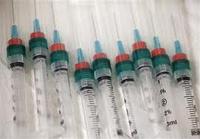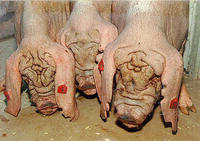-
New way to design vaccines: modifying antibodies to trigger immune response
In an approach with the potential to aid therapeutic vaccine development, scientists have shown that enzymatically modified antibodies can be used to generate highly targeted, potent responses from cells of the immune system
-
-
FDA issues new food safety rules to fight contamination
One in six Americans becomes ill from eating contaminated food each year; most of them recover without harm, but bout 130,000 are hospitalized and 3,000 die; the FDA estimates the new food safety rules could prevent about 1.75 million illnesses each year
-
-
New strategy for bacteria antibiotic resistance
Scientists used microfluidics to observe the behavior of individual tuberculosis-like bacteria in the presence of antibiotics; their observations call into question the prevailing theory of bacterial resistance, and they have proposed a new explanation for why some bacteria become resistant
-
-
Thousands at risk from dirty syringes used in clinics, hospitals

U.S. health officials are still fighting a battle which was supposed to be over more than fifty years ago: dirty needles (the disposable syringe became widely available in the early 1960s); in the last eleven years, more than 150,000 patients nationwide were victims of unsafe injections, and two-thirds of those injections have been administered since 2008
-
-
Hydrogen peroxide vapor kill superbugs dead
Infection control experts at the Johns Hopkins Hospital have found that a combination of robot-like devices that disperse a bleaching agent into the air and then detoxify the disinfecting chemical are highly effective at killing and preventing the spread of multiple-drug-resistant bacteria, or so-called hospital superbugs
-
-
The burden of disease links ecology to economic development and growth
According to conventional economic wisdom, the foundation of economic growth is in political and economic institutions; researchers argue that, in fact, vector-borne and parasitic diseases have substantial effects on economic development across the globe, and that these diseases are major drivers of differences in income between tropical and temperate countries; the burden of these diseases is, in turn, determined by underlying ecological factors: it is predicted to rise as biodiversity falls
-
-
Natural defense against malaria identified
One of the world’s most devastating diseases is malaria, responsible for at least a million deaths annually, despite global efforts to combat it; researchers have identified a protein in human blood platelets that points to a powerful new weapon against the disease
-
-
Texas drought helps in demonstrating viability of drought-tolerant corn
There is nothing like a couple years of drought to help determine the advances being made in drought-tolerant corn, and the historic drought in Texas in 2011 and in the Corn Belt in 2012 helped Texas A&M scientists show that different types of drought-tolerant corn performed well with far lower levels of irrigation
-
-
Budget cuts cause states to lose ground on emergency preparedness
A new report examines the preparedness of states for different emergencies, including plans to evacuate children from schools, vaccination requirements, disease outbreaks, the ability to deal with chemical terrorism, staffing for a prolonged infectious disease outbreak, having a multi-hazard written evacuation plan, Medicaid coverage of flu shots, nurses’ ability to work in other states, and other emergency factors; the report found that only five states met eight of the ten measures used to evaluate public health preparedness
-
-
Pigs in southern China found to be infected with avian flu

Researchers report for the first time the seroprevalence of three strains of avian influenza viruses in pigs in southern China, but not the H5N1 avian influenza virus; their research has implications for efforts to protect the public health from pandemics
-
-
Antibiotics based on a new principle may defeat MRSA, TB
Scientists at Karolinska Institutet have presented a new principle for fighting bacterial infections, in other words, a new type of antibiotic; the new antibiotic mechanism is based on selectively blocking the thioredoxin system in the cells, which is crucial to the growth of certain bacteria; scientists hope to be able to treat such conditions as stomach ulcers, TB, and MRSA
-
-
New, quick way to ID people exposed to dirty bomb, radioactive radiation
Research conducted by scientists from the Berkeley Lab could lead to a blood test that detects if a person has been exposed to radiation, measures their dose, and separates people suffering from inflammation injuries — all in a matter of hours
-
-
New food-safety tests may not be very good at detecting food poisoning outbreak
CDC reports that one in six Americans get sick from food- borne illnesses every year, and 3,000 people a year die from food poisoning; new detection method for food-borne illnesses will be faster to detect an illness, but these new tests cannot detect specific differences between different subtypes of bacteria, as current tests can; the ability to detect these differences is what states and the federal government use to match a sick person to a contaminated food source
-
-
Haiti's food situation looks bleak in Sandy’s aftermath
The aftermath of Hurricane Sandy, which ripped through southern Haiti in October, will extend beyond destruction and injury; the current and future food security looks bleak barring significant intervention during the next year
-
-
EPA issues new soot pollution standard over industry’s objections
The Environmental Protection Agency (EPA), acting under court order, on Friday issued a new standard for soot pollution; the agency estimates the cost of complying to be between $53 million and $350 million – and the estimated benefits to be between $4 billion and $9 billion; utilities, manufacturers, chemical companies, and the oil and gas industry asked for a delay in issuing the rule, arguing it would be costly to implement
-
More headlines
The long view
A Shining Star in a Contentious Legacy: Could Marty Makary Be the Saving Grace of a Divisive Presidency?
While much of the Trump administration has sparked controversy, the FDA’s consumer-first reforms may be remembered as its brightest legacy. From AI-driven drug reviews to bans on artificial dyes, the FDA’s agenda resonates with the public in ways few Trump-era policies have.
